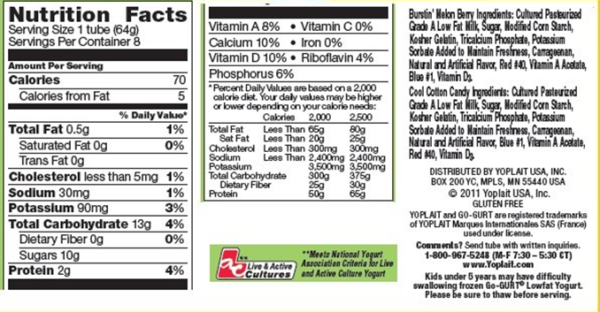By Laura Clapper, clinical dietitian at CHOC
Yogurt consumption has increased dramatically in recent years, especially Greek yogurt, for good reason. It contains important nutrients such as protein, calcium, potassium, and some are fortified with vitamin D for additional bone health. Current dietary guidelines recommend children consume 2-3 cups of low-fat dairy per day.
Many cultures around the world have consumed yogurt for over 2,000 years, but now the yogurt industry is taking over the dairy section of today’s local grocery stores. A few years ago, the yogurt choices were fruit on the bottom or mixed. Now, it can be overwhelming with so many options!
How do you know the right kind to buy for your family?
Some are packed with sugar, and some have more nutritional value than others.
Plain Yogurt
Made by heating milk, cooling it, adding live cultures (or probiotics, which are considered “good bacteria”) and letting the mixture ferment until lactic acid is formed and the product gains a thicker consistency. This process is the base for many other yogurts. It retains liquid whey, which is high in calcium. It also is the mildest form of all the yogurts, which makes it an appealing option for children. Look for a seal on the label that says “Live and Active Cultures” to ensure the product was manufactured with a minimum of 100 million cultures per gram. These can be beneficial to the gut and immune system.
Greek Yogurt
Made using the same process as plain yogurt, but most of the liquid whey is strained away. Nutritionally, Greek yogurt has more protein, less lactose and fewer carbohydrates than regular plain yogurt. Manufacturers will often add back calcium which is lost with the whey. It is thicker, creamier and has a more tangy flavor than regular yogurt.
Skyr Yogurt
Pronounced Skeer, and commonly referred to as Icelandic yogurt, special Skyr cultures from Iceland are used to ferment nonfat milk. Water is strained away for a thick and creamy texture, leaving a high-protein product that has the same flavor as Greek yogurt, but a milder flavor and mouthfeel.
Kefir Yogurt
Kefir is a tart and tangy drinkable yogurt, using grains of a yeast starter to begin the fermentation process. It can be an acquired taste for some people, but those who prefer this kind enjoy the carbonation and thin consistency. People with lactose intolerance might be interested in giving this one a try, as it contains a very low amount of lactose.
Swiss Yogurt
Also known as stirred yogurt, this type of yogurt is thinner and creamier than Greek yogurt. It is made from cultured milk that is incubated and then cooled in a large container. Watch out, though: Swiss yogurt can have almost double the sugar and carbohydrates than Greek yogurt!
Organic Yogurt
According to the USDA, what you do get from organic dairy products is the benefit of knowing that no growth hormones or antibiotics were used on the animals that produced the dairy. It contains no pesticide residue from added fruits, and no GMOs.
Grassmilk Yogurt
It refers to yogurt made from the milk of cows that have been grazing on grass, with no grain, corn or soy as part of their diet — good for the cows, and good for us. It’s a nutrient-dense yogurt which is rich and higher in omega-3s.
Be aware of added sugars in yogurt
Within each of these categories you can choose nonfat, low-fat or full fat versions, creamy, whipped, soy milk, fruited flavors, or added fibers. But whichever one you choose, take time to glance at the label. All yogurt will have sugar listed because all yogurt naturally contains the milk sugar lactose. Expect around 7-15 grams of naturally occurring sugar for a six-ounce serving. The new labels starting to come out this year differentiate between naturally occurring sugar and added sugar. Skip the added sugars by adding your own sweetness with fruit, cinnamon or a touch of honey.
Drinkable and squeezable yogurts are often marketed to kids but contain added colors, sugars and artificial flavors. Look at the added sugars in this nutrition label of a popular tube yogurt for kids:

Yogurt can be used in a variety of ways and at any time of the day. For breakfast, try it as a spread on toast or as part of a smoothie. For lunch or dinner, use in place of sour cream, heavy cream, or mayonnaise in recipes for pasta, tuna or potato salad. Mediterranean dishes feature dips and sauces such as raita, tzatziki and labreh made with yogurt and spices. For dessert, try freezer-mold popsicles with equal parts yogurt, nonfat milk and fruit. Or for a parfait, layer yogurt with fresh fruit, berries, or angel food cake and top with a sprinkle of high fiber granola and serve in clear containers. Any way you serve it up, your kids will love this delicious, healthy treat.





